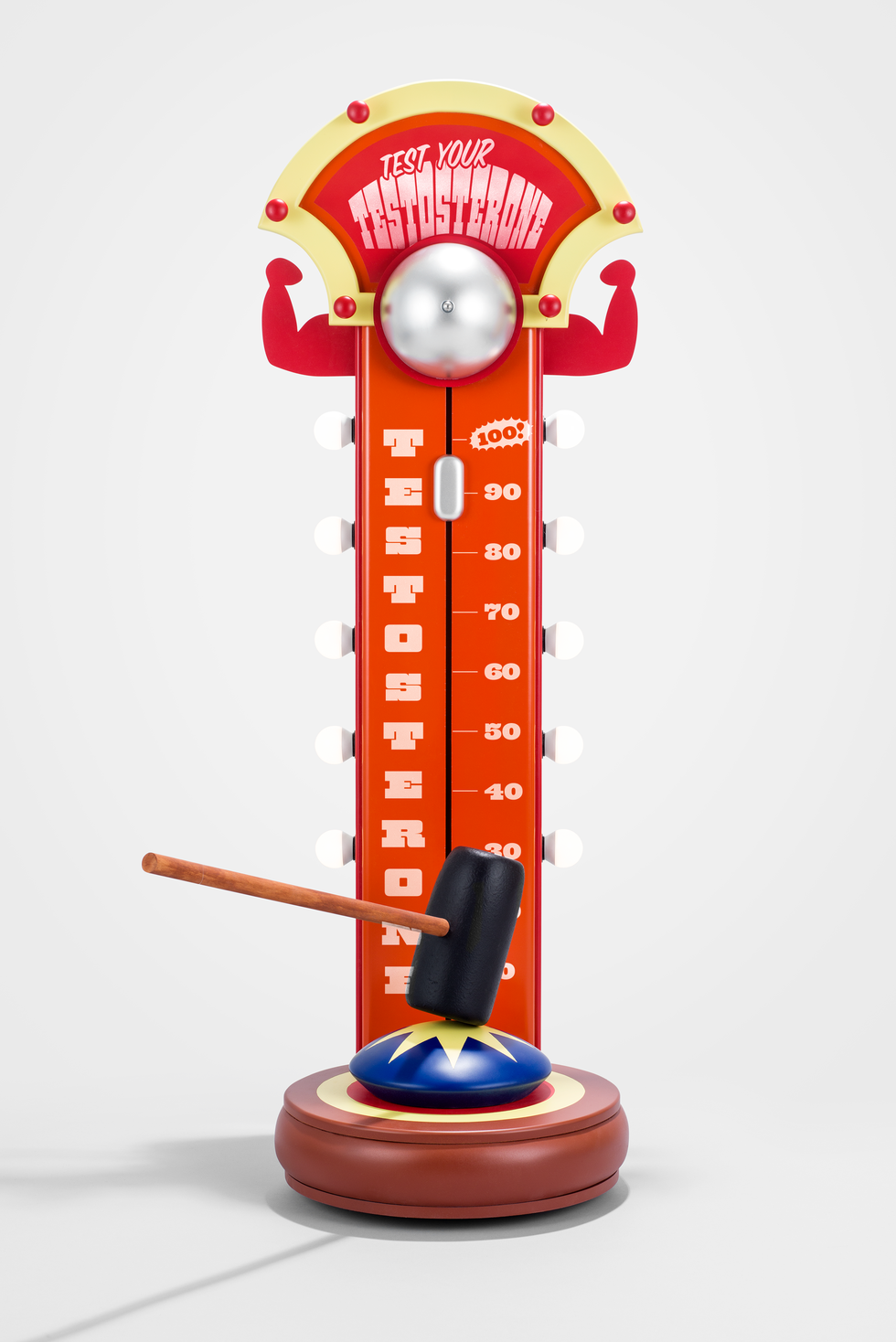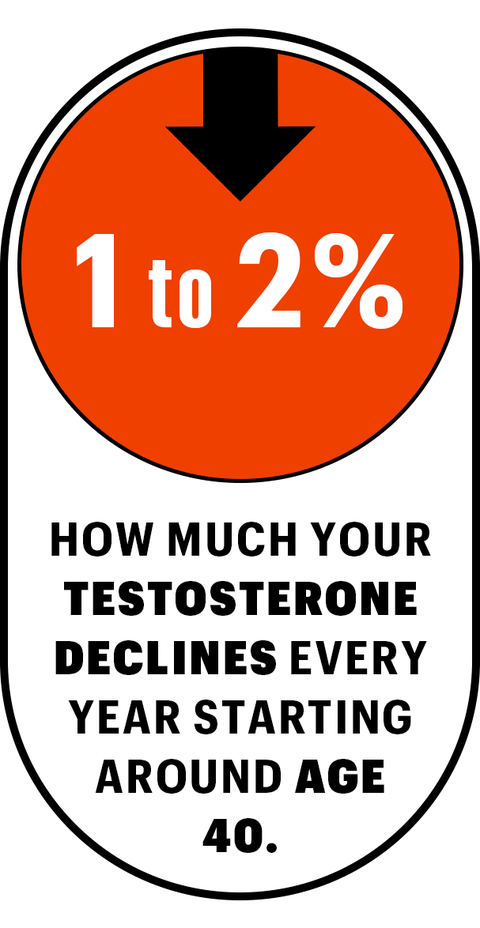This story is part of our annual Fit At Any Age series—a guide to the innovations and breakthroughs in aging to help you live a stronger, longer life.
FOR A LONG TIME, we accepted certain changes as the price (and privilege) of getting older. Your hair turns gray. Your hearing starts to…wait, what was that you said? And, of course, your testosterone level drops. But with a boom in testosterone-replacement clinics—by this point, who hasn’t gotten an ad for a service offering to test your T for under $100?—and podcasts and influencers preaching the powers of hormone optimization, should guys over 40 think about winding back their T clocks? And by how much? Here’s what to know.
T Can Help You Live Longer
A shortage of testosterone is associated with a shorter life. “We now have several decades of high-quality research showing remarkable longevity and health benefits in men with normal testosterone levels compared with men with low levels,” says Abraham Morgentaler, M.D., at Harvard Medical School and the author of Testosterone for Life. That’s true whether guys have healthy levels naturally or underwent testosterone-replacement therapy to bring their levels out of the low range.
T Can Make You Feel Better, Too
Feeling young and alive often boils down to a few things, says Dr. Morgentaler: being strong, staying active, and having the energy to do the activities you enjoy. “Men with low T often lose many of those things; people say they feel old,” he adds. “Not only do men feel better with normal testosterone levels, but for a whole variety of general medical and health issues, they actually are better.” That means improvements in sexual function, physical function, and mood, according to a major study in The New England Journal of Medicine in 2016.
But Testosterone Levels Decline with Age
A man’s testosterone level drops about 1 to 2 percent a year, starting around age 40. Docs generally don’t prescribe T replacement unless a guy’s level is low (less than 300 ng/dL) and he has symptoms of testosterone deficiency: reduced libido, erectile dysfunction, fatigue, lack of motivation, insomnia, depression, reduced muscle mass, and weight gain.
Yet even without symptoms, men are clamoring to replace that age-related loss, because why wouldn’t you want your level to be the same at 60 as it was at 30? Bradley Anawalt, M.D., a professor of medicine at the University of Washington School of Medicine, echoes the reasoning of other top testosterone researchers when he says, “The simple answer is that we do not know if it is beneficial or harmful to give testosterone to a man whose concentration drops with aging.” If your T level is in the gigantic normal range (264 to 916 ng/dL) and you’re not experiencing any low-T symptoms, it’s hard to argue that you need more of it.
“There’s what I call a ‘threshold effect.’ Once you’re above it, you’re just normal; it’s hard to be more normal than normal,” says Dr. Morgentaler. “For the most part, somebody who has normal testosterone levels will not notice anything if he takes some testosterone and goes into the upper range.” Or as Dr. Anawalt puts it, “The difference between a level of 450 or 445 is clinically nonsense. From day to day, you can have a variation of about 10 to 20 percent, and within the day, you can have a variation of about 5 to 35 percent.” So wanting to correct for that 1 to 2 percent a year is understandable, but top researchers aren’t willing to encourage you to go for it yet.
There are Other Ways to prevent Age-Related Muscle Loss
It’s true that you lose muscle fibers as you get older. While testosterone increases muscle strength and mass, hormone replacement might not be able to prevent muscle-fiber loss. “It just makes the muscle fibers that remain bigger,” says Dr. Anawalt, and it’s not certain that this has age-reversing benefits. But if you have a deficiency, T therapy can restore vitality and may help motivate you to do the workouts that will build muscle strength and mass.
How to Know if You’re Normal for Your Age
Beware anyone telling you that you, at 30, 40, 50, or even 60, have the testosterone level of a 70-year-old. There is a giant reference range regardless of age, so at 70, “normal” remains within a 650-point span. “If you take 10,000 men who are 20 years old, the average testosterone might be 550 or 500,” says Dr. Anawalt. “The average testosterone in 10,000 70-year-olds might be 380 or 400. But they’re both in the normal range. It doesn’t mean you have the testosterone of a 70-year-old when you have a testosterone of 400 at age 20.” You have a normal level for both ages.
There’s a movement by influencers and early adopters to stack up your level against yourself, not against other people your age. They advocate getting a baseline testosterone test early in life (or now, if you didn’t do it in your 20s or 30s), so you can see how your levels compare later on. The test fee may or may not turn out to be a good investment. If you do choose to get one, be aware that all testosterone tests aren’t equal. Right now, different labs may give you different results when you have your testosterone level tested. The way to get an accurate number is kind of clunky, but you need to ask the test purveyor, “Has this lab test been validated and certified by the CDC?” Those that have been provide an accurate number and meet the most up-to-date standards of what “low” is.
When Not to Take T
Testosterone therapy isn’t recommended if you hope to start a family. When you’re on it, your body produces less T and, in turn, fewer or no sperm. Most of the time, when you stop T therapy, production returns, but not always like before.
Later this year, the results of a blockbuster testosterone trial should answer lingering questions about T’s cardiovascular safety and benefits. But doctors make it clear that if your level is low and you’re suffering, you can benefit from increasing it. In other words, the benefit-to-risk ratio is favorable when you treat the right people (those with testosterone deficiency). “Testosterone has a bad rap,” says Dr. Morgentaler, as it’s been associated with bodybuilders and cheating athletes. Yet there are years of data on it; it’s been on the market since the 1930s.
Just make sure low T is what’s causing your symptoms. Weight gain, fatigue, ED, and lack of motivation and concentration all have other causes. And obesity, smoking, excessive alcohol use, and a lack of sleep may also be responsible for low testosterone. Manage those and you may be able to naturally raise your testosterone level and improve the number and the quality of the years ahead. After all: “If you have a garden with a bunch of overgrown weeds, planting more flowers is not necessarily going to make for a more beautiful garden,” Dr. Anawalt says. “You need to actually get rid of the problem.”
This story originally appeared in the April 2023 issue of Men’s Health.

Freelance Writer
Cassie Shortsleeve is a skilled freelance writer and editor with almost a decade of experience reporting on all things health, fitness, and travel. A former Shape and Men’s Health editor, her work has also been published in Women’s Health, SELF, Runner’s World, Men’s Journal, CNTraveler.com, and other national print and digital publications. When she’s not writing, you’ll find her drinking coffee or running around her hometown of Boston.





Comments are closed.